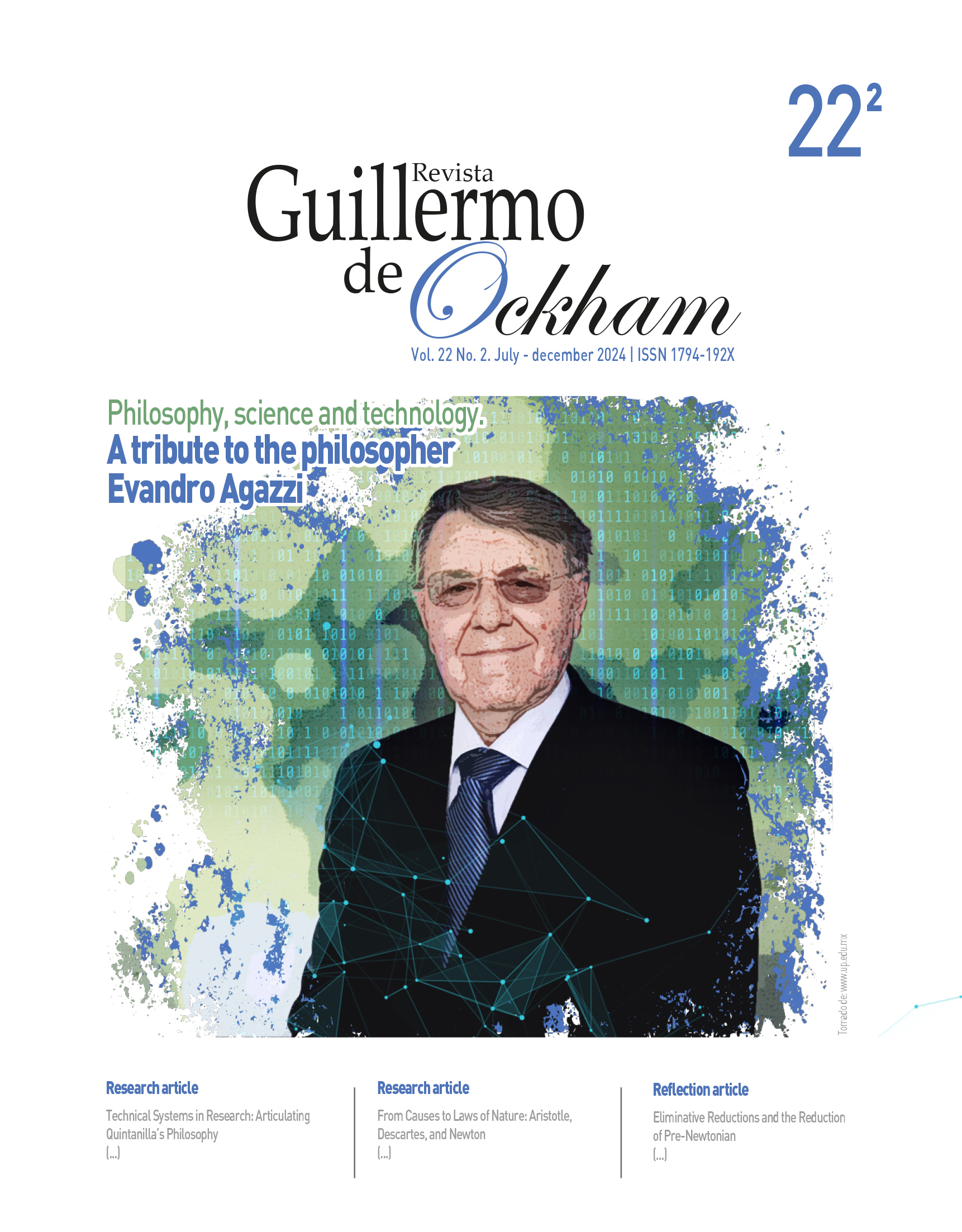The Revista Guillermo de Ockham provides an immediate and open access to its content, based on the principle of offering the public a free access to investigations to provide a global interchange of knowledge.
Unless otherwise established, the contents of this journal has a license with Creative Commons Attribution-NonCommercial-NoDerivatives 4.0 International (CC BY-NC-ND 4.0) http://creativecommons.org/licenses/by-nc-nd/4.0/
- Attribution: You must give appropriate credit, provide a link to the license, and indicate if changes were made. You may do so in any reasonable manner, but not in any way that suggests the licensor endorses you or your use.
- NonCommercial: You may not use the material for commercial purposes.
- NoDerivatives: If you remix, transform, or build upon the material, you may not distribute the modified material.
- No additional restrictions: You may not apply legal terms or technological measures that legally restrict others from doing anything the license permits.
Abstract
This article aims to show the great variety of ways in which new ideas enter science; ideas that must pass both the critical examination of the scientific community and the filter of empirical contrast. The community itself is aware of the role that conjectures, intuitions, and imagination play in the advancement of science. A fundamental role in the context of discovery is played by abduction, a form of reasoning that serves the purposes of theoretical innovation and scientific explanation, which I illustrate by focusing on the anomalous Zeeman effect, which is very appropriate to the case. But I also point out that in preductive reasoning, a genuinely deductive form of inter-theoretical reasoning, imagination, and luck should not be excluded when choosing the theoretical elements whose step-by-step combination leads to a novel theoretical result.
Keywords:
References
Bohr, N. (1913). On the constitution of atoms and molecules. Philosophical Magazine, 26(151), l–25.
Boltzmann, L. (1884). Ableitung des Stefan'schen Gesetzes, betreffend die Abhängigkeit der Wärmestrahlung von der Temperatur aus der electromagnetischen Lichttheorie. Annalen der Physik, 258(6), 291–294. https://doi.org/10.1002/andp.18842580616
Compton, A. H. (1923). A quantum theory of the scattering of X-rays by light elements. The Physical Review, 21(5), 483–502. https://doi.org/10.1103/PhysRev.21.483
Coulson, C. A. (1952). Valence. Clarendon Press.
Einstein, A. (1967). On a heuristic point of view about the creation and conversion of light. In D. ter Haar, The old quantum theory (pp. 91–107). Pergamon Press.
Ekstrand, A. G. (1920, June 1st). Award ceremony speech. The Nobel Prize. https://www.nobelprize.org/prizes/physics/1918/ceremony-speech/
Feshbach, H. (1998). The story of spin. Sin-itiro Tomonaga (translated by Takeshi Oka). 258 pp. University of Chicago Press, Chicago, 1997. American Journal of Physics, 66(9), 839–840. https://doi.org/10.1119/1.18975
Franck, J., & Hertz, G. (1967). On the excitation of the 2536 Å mercury resonance line by electron collisions. In D. ter Haar, The old quantum theory (pp. 160–166). Pergamon Press.
Hermann, A. (1965). Arthur Erich Haas und der Quantenansatz für das Atom. Sudhoffs Archiv für Geschichte der Medizin und der Naturwissenschaften, 49(3), 255–268. http://www.jstor.org/stable/20775207
Hund, F. (1978). Geschichte der physikalischen Begriffe: Die Wege zum heutigen Naturbild (Vol. 2). Bibliographisches Institut, Mannheim.
Jammer, M. (1989). The conceptual development of quantum mechanics (2nd ed.). American Institute of Physics.
Kragh, H. (2007). Generaciones cuánticas: una historia de la física en el siglo XX. Akal.
Kuhn, T. (1980). La teoría del cuerpo negro y la discontinuidad cuántica. Alianza.
Landau, L. D., & Lifshitz, E. M. (1992). Teoría clásica de los campos (2nd ed.). Reverté.
Lodge, O. (1897). The influence of a magnetic field on radiation frequency. Proceedings of the Royal Society London, 60, 513–514.
Maravall, D. (1950). La cuantificación del espacio y del tiempo en la mecánica ondulatoria. Euclides, 10(113–114), 247–251.
Medawar, P. (1974). Hypothesis and imagination. In A. Schilpp (Ed.), The philosophy of Karl Popper (Vol. 1, pp. 274–291). Open Court.
Mehra, J., & Rechenberg, H. (1982). The historical development of quantum theory (Vol. 1, Part 2). Springer.
Nicholson, J. W. (1912). The constitution of the solar corona. IL. Monthly Notices of the Royal Astronomical Society, 72(8), 677–692. https://doi.org/10.1093/mnras/72.9.729
Pauli, W. (1925). On the connexion between the completion of electron groups in an atom with the complex structure of spectra. Zeitschrift für Physik, 31, 1–13. http://www.fisicafundamental.net/relicario/doc/Pauli_1925.pdf
Pauli, W. (1946). Remarks on the history of the exclusion principle. Science, 103(2669), 213–215. https://doi.org/10.1126/science.103.2669.213
Pauli, W. (1996). Escritos sobre física y filosofía. Debate Pensamiento.
Peirce, C. S. (1965). Collected papers. Harvard University Press.
Planck, M. (1900). On an improvement of Wien’s equation for the spectrum. Verhandlungen der Deutschen Physikalischen Gesellschaft, 2, 202.
Planck, M. (1920, June 2nd). The genesis and present state of development of the quantum theory. The Nobel Prize. https://www.nobelprize.org/prizes/physics/1918/planck/lecture/
Planck, M. (1949). Zur Geschichte der Auffindung des physikalischen Wirkungsquantum. In Vorträge und Erinnerungen (pp. 15–27). S. Hirzel Verlag.
Planck, M. (1967). On the theory of the energy distribution law of the normal spectrum. In D. ter Haar, The old quantum theory (pp. 82–90). Pergamon Press.
Poincaré, H. (1963). La ciencia y la hipótesis. Espasa-Calpe.
Popper, K. (1980). Lógica de la investigación científica. Tecnos.
Rivadulla, A. (2002). La solución revolucionaria de Planck del problema de la radiación del cuerpo negro. In C. Mataix and A. Rivadulla (Eds.), Física cuántica y realidad (pp. 43–56). Editorial Complutense.
Rivadulla, A. (2003). Revoluciones en física. Trotta.
Rivadulla, A. (2016). Complementing standard abduction: Anticipative approaches to creativity and explanation in the methodology of natural sciences. In L. Magnani and C. Casadio (Eds.), Model-based reasoning in science and technology (Vol. 27, pp. 319–328). Springer. https://doi.org/10.1007/978-3-319-38983-7
Rivadulla, A. (2021). From the atom to the cosmos, in three stories on the weight of imagination in science. In C. Barés, F. J. Salguero and F. Soler (Eds.), Lógica, conocimiento y abducción: homenaje a Ángel Nepomuceno (pp. 31–346). College Publications.
Rivadulla, A. (2022). Tracking abductive reasoning in the natural sciences. In L. Magnani (Ed.), Handbook of abductive cognition (pp. 1–27). Springer. https://doi.org/10.1007/978-3-030-68436-5_75-1
Rosenthal-Schneider, I. (1949). Wissenschaftliche Selbstbiographie by Max Planck. Isis, 40(1), 67–69.
Rovelli, C. (2007). Quantum gravity. In J. Butterfield and J. Earman (Eds.), Handbook of the philosophy of science (pp. 1287–1329). Elsevier. https://doi.org/10.1016/B978-044451560-5/50015-4
Shaik, S., Danovich, D., & Hiberty, P. C. (2021). Valence bond theory—its birth, struggles with molecular orbital theory, its present state and future prospects. Molecules, 26(6), 1624. https://doi.org/10.3390/molecules26061624
Smolin, L. (2001). Three roads to quantum gravity. Basic Books.
Sommerfeld, A. (1923). Atomic structure and spectral lines (H. L. Brose, Trans.). E. P. Dutton and Company Publishers.
Thomson, J. A. (1911). Introducción a la ciencia. Labor.
Tyndall, J. (1870). On the scientific use of the imagination. Longmans, Greens, and Co.
Zeeman, P. (1897). The effect of magnetisation on the nature of light emitted by a substance. Nature, 55(1424), 347. https://doi.org/10.1038/055347a0
































